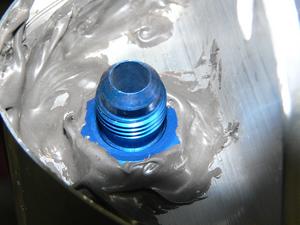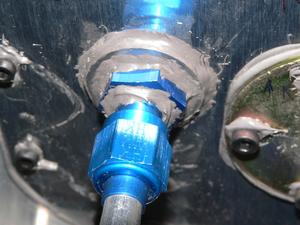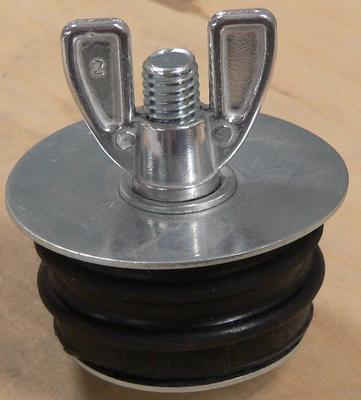I got up early this morning and hit Home Depot when they opened at 8 AM. I searched the plumbing section high and low, and finally found a 2" plumbers test plug. It is a cylindrical piece of rubber, with a thick steel disk on each end of the cylinder. There is a large bolt through the two disks with huge wing nut. You insert the plug in the item to be sealed, then turn the wing nut to compress the rubber, causing its diameter to increase. I stuck one in the fuel filler hole and snugged it in place. No more leak there.
 It took a lot of trial and error with soapy water, but I finally found a slow leak at the fitting where the fuel line attaches to the fuel tank. There is a bulkhead fitting that comes through a hole in the tank. A large aluminum nut on the outside secures it in place. I had put Pro-seal around the edges of the nut, but I didn't seal the interface between the nut threads and fitting. I've got a small leak at the threads. It is pain to have a leak to fix, but the good news is that I don't have to open the tank up to fix it. I have to put some sealant around that threaded joint.
It took a lot of trial and error with soapy water, but I finally found a slow leak at the fitting where the fuel line attaches to the fuel tank. There is a bulkhead fitting that comes through a hole in the tank. A large aluminum nut on the outside secures it in place. I had put Pro-seal around the edges of the nut, but I didn't seal the interface between the nut threads and fitting. I've got a small leak at the threads. It is pain to have a leak to fix, but the good news is that I don't have to open the tank up to fix it. I have to put some sealant around that threaded joint.
 This is the fuel outlet fitting on the other tank. You can see that I did cover the threads with Pro-seal on this tank. I don't know why I didn't do that on the other one.
This is the fuel outlet fitting on the other tank. You can see that I did cover the threads with Pro-seal on this tank. I don't know why I didn't do that on the other one.
The fittings on the two tanks are in different places because the left tank has a flop tube for fuel pick up. The flexible tube has a weight on the fuel pickup end, so it goes to the top of the tank in inverted flight. The other end of the tube is connected at the very front of the inboard tank rib, so that is where the fuel line attaches. The right tank has the normal fuel pickup, which only works in normal flight. The fuel line attaches to its fitting in the middle of the inboard tank rib.
This afternoon I hooked up the right tank for its leak test. I had a slow leak, but finally found that I needed to tighten the connection at the fuel line fitting. It was only finger tight. I fixed that, but the water level in the manometer was still coming down a bit. I spent a long while with the soapy water, but couldn't find a leak. I went back down a few minutes ago, and the water level has increased since the last check. I guess the air from the air compressor was warmer than the basement, so the pressure decreased while it was cooling down. Now it has reached equilibrium, so the water level should go up and down as the temperature varies. I'll leave it for a day or so to see whether it is holding pressure.
So, I have to seal up that leak on the left tank, but the initial indications are the right tank doesn't leak. And I have to eventually get the fuel caps to stop leaking. Not as bad as I feared, but not as good as I hoped either.
Update - 1 Dec 05
I left the right tank pressurized for two and a half days. The water manometer level fluctuated up and down a couple of inches, as the temperature in the basement went up and down, and the atmospheric pressure changed. But, the average manometer level didn't decrease, so I'm satisfied that there is no leak.
 Here is a shot of the 2" plumbers test plug that I used to seal the filler cap opening.
Here is a shot of the 2" plumbers test plug that I used to seal the filler cap opening.